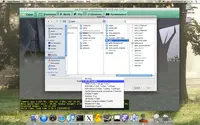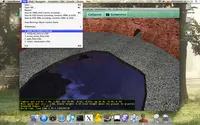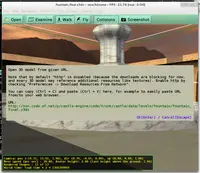Development: better Mac OS X support, networking, CAD level 2, more
 |
 |
 |
 |
Hello everyone!
There is a contest for best open-source project on Polish portal http://www.spinacz.edu.pl/. Please take a moment to vote for our Castle Game Engine!
Our engine was submitted to devmaster.net, with lots of information and screenshots. You're welcome to review and rate us there!
We also want to remind that we have a Google+ page about our Castle Game Engine, you can follow it to see (a little more frequent) news about our engine development.
New engine features in development:
Mac OS X with native look. This is already much more user-friendly than our previous GTK-based releases for Mac OS X. See development details. Hopefully, this will allow us to release next view3dscene as normal Mac OS X application, that will be trivial to install for Mac OS X users.
Network (http) support. Most "FileName" parameters and properties are now URLs. You can use protocols like
file:andhttp:anddata:everywhere, and of course http will be automatically downloaded. Try view3dscene from snapshots, enable "Preferences->Download Resources From Network" and then use menu item (Ctrl+L) to load URL, or pass URL on the command-line.This is a little user-unfriendly, as the downloading is blocking (the process waits for the download to finish, instead of letting you enjoy the game and download in the background; there isn't even any nice way to cancel the download, or even notification about it, except for --debug-log message). For this reason, it is disabled by default: you have to explicitly allow it by "Preferences->Download Resources From Network" (in code:
CastleDownload.EnableNetworkvariable).For some test scenes on the Internet, try e.g. Inline demo or Texture demo or AudioClip demo. (from ConformanceNist X3D Examples Archive). Or see our demo models through http, by browsing through SVN http link.
view3dscene automatically downloads the model, as well as all linked resources (textures, inline models, sounds, scripts etc.). You can also use VRML/X3D Anchors to jump to any URL (for example, you can jump from a local file to a model available through http). Also data: URI handling is now more uniform. Also the engine uses now MIME types more, instead of merely file extensions. This makes us work with http transfers, and improves cooperation with data: URIs.
In a game, you could also use URLs inside files like
level.xmlandresource.xml. For example, you could distribute now a level.xml file that contains URLs to levels on your server, downloaded each time.Clipboard (Ctrl+C, Ctrl+V, Ctrl+X in message boxes, especially handy to copy/paste URLs). For developers: use
Clipboard.AsTextproperty. Implemented for CastleWindow WinAPI, GTK, LCL backends.CAD level 2 support (CADXxx nodes).
Improvements to 2D rendering. They also workaround crashes on some Mesa 9 drivers.
Support for 8 and 16 samples for anti-aliasing, there are (at least NVidia) GPUs supporting it.
Renamed our event
IdletoUpdate.This reflects our implementation and usage of this event clearer. This event is for continuous tasks, called even when the application is not "idle" (when application is processing something, like mouse moves). Our
Updateevent doesn't correspond 100% to normal (as used by LCL or GTK) meaning of "idle" (which is also evidenced by code if TCastleWindow LCL and GTK backends, that cannot simply use LCL/GTK "idle" concepts to implement our Update).TCastleControl.AggressiveUpdate*are removed. The (simplified and improved) version of this mechanism is now always "on" and automatically makes mouse look work better. It's still not perfect (it seems LCL event loop is just too slow to process events during mouse look fast enough), but it's better now. If you want perfectly smooth mouse look, you should still consider TCastleWindow instead of TCastleControl.
- (2015-07-05) Castle Game Engine 5.2.0 release
- (2015-01-11) Castle Game Engine 5.1.2 release (fixes to TCastleControl, tutorial, more)
- (2014-12-30) Castle Game Engine 5.1.1 release (Spine, build tool, more), view3dscene 3.15.0 release
- (2014-05-01) Castle Game Engine 5.0.0 release (Android, iOS, more), view3dscene 3.14.0 release
- (2014-01-02) Development: Android and iOS, new game release "Darkest Before the Dawn", more
- (2013-09-15) Development: great API for 2D games and UI, our engine in Debian, on the road to OpenGL ES, Orcs and Volcanoes game screenshots
- (2013-08-17) Castle Game Engine 4.1.1, view3dscene 3.13.0 release and more
- (2013-05-12) Development: transitionComplete, Debian packages, network tutorial, data URI, MultiTexture tests, more
- (2013-04-19) Development: better Mac OS X support, networking, CAD level 2, more
- (2013-01-26) Castle Game Engine 4.0.0 release! And view3dscene 3.12.0, and castle 1.0.0, and more
- (2013-01-17) Development: engine 4.0.0 release in a few days, many improvements this month
- (2012-11-14) Development: engine 4.0.0 - still almost there: a lot of creatures, items and player improvements
- (2012-09-15) Development: engine 4.0.0 - almost there: levels, items, player improvements
- (2012-08-16) Development: new engine: levels, items, player, tutorial, class diagram, more
- (2012-07-10) Development: water with caustics, lights editor, force Phong shading, shadow volumes improvements, more
- (2012-06-10) Development: creature AI, start of architecture mode, fractals demo, more
- (2012-05-12) Development: 3D mouse, drag to walk, SSAO, screen effects with anti-aliasing, triangulation, X3D 3.3, soft shadows demo, VisibilitySensor, 3D world improvements for games
- (2012-01-13) Development: virtual trackball, URLs, BitCoin, T3DTransform, Win64, and more
- (2011-12-31) view3dscene 3.11.0, engine 3.0.0 releases
- (2011-12-23) Development news: fixed view and isometric games in engine examples, shadow maps improvements, color interpolation in HSV space
- (2011-11-14) Development news: Geometry shaders, my Ph.D. thesis, cellular texturing
- (2011-10-13) Development news: grand rename to "Castle Game Engine" finished, more
- (2011-09-23) Rename "Kambi VRML game engine" to "Castle Game Engine", moving to SourceForge Allura platform, my slides from TPCG11
- (2011-08-22) Engine rename to "Castle Game Engine" soon, development news: some important fixes / improvements, many API improvements
- (2011-07-31) Development news: huge Collada import improvements
- (2011-07-25) view3dscene 3.10.1, engine 2.5.1 released: XML output
- (2011-07-02) view3dscene 3.10.0, engine 2.5.0, demo models 3.0.0 released
- (2011-06-20) Development news: lights improvements, shadow volumes in demo_models, Hunter's Mark, more
- (2011-06-01) Development news: many shader pipeline improvements, many 3DS/Wavefront etc. converters improvements, more
- (2011-04-21) Development news: Engine 2.4.4 fixes release, ColorSetInterpolator
- (2011-04-09) Development news: Finishing shader rendering, steep parallax bump mapping reimplemented, engine 2.4.1 fixes release
- (2011-03-08) Development news: Beautiful shader rendering, compositing shaders extensions, shadow maps, Blender X3D exporter mods, and more
- (2011-02-06) view3dscene 3.9.0: new renderer, GLSL attributes, multiple viewports. Also: "fundry", a way to donate to particular feature
- (2011-01-18) Development news: first milestone of new renderer reached, GLSL attributes and other new features
- (2011-01-06) view3dscene 3.8.0: 3D sound, skinned H-Anim, more
- (2010-12-22) Development news: animating skinned H-Anim humanoids
- (2010-12-02) Development news: major improvements to engine API reference, future plans
- (2010-11-18) view3dscene 3.7.0 release: Screen effects, drag sensors, ClipPlane, Billboard, toolbar and much more
- (2010-11-10) Development news: Billboards, transform optimizations, UI: toolbars and hints, more
- (2010-10-17) Development news: drag sensors, KambiScript rotations, mouse wheel, more
- (2010-10-10) Website facelift
- (2010-09-30) Development news: Examine improvements, smooth transitions, PlaneSensor and more
- (2010-09-18) Development news: ClipPlane, CHM docs, optimizations and more
- (2010-08-08) view3dscene 3.6.0 release: Many shadow maps improvements
- (2010-07-09) Development news: Many shadow maps improvements, castle fountain, more
- (2010-04-18) view3dscene 3.5.2 release: IMPORT/EXPORT and bugfixes
- (2010-04-05) view3dscene 3.5.1 bugfix release, glinformation 1.2.0
- (2010-03-30) Release: view3dscene 3.5.0, engine 2.0.0, others
- (2010-03-27) Custom viewports, engine 2.0.0 release very soon
- (2010-03-11) Terrain demo much extended
- (2010-02-26) Cloth animation with bump mapping
- (2010-02-04) More engine 2.0 news: all examples and "The Castle" use scene manager
- (2010-01-26) Development news: engine 2.0
- (2009-12-21) News - terrain demo, large engine layout changes
- (2009-10-30) News - LGPL, SSAO demos, White Dune, more
- (2009-09-07) Development news - more NURBS: interpolators, VRML 97 compatibility
- (2009-09-05) Development news - NURBS basics
- (2009-08-26) view3dscene 3.4 release - advanced texturing
- (2009-08-13) News from SVN - RenderedTexture node, Viewpoint.camera*Matrix events, and more
- (2009-05-05) News from SVN - 3D textures, shadow maps, hardware occlusion query and more
- (2009-04-10) News from SVN — X3D multi-texturing, cube maps and more
- (2009-01-24) Dynamic Ambient Occlusion, Shadow Fields demos in the engine sources
- (2009-01-03) view3dscene 3.3, engine 1.7 release: LOD, Collision.proxy, and more
- (2008-12-18) view3dscene 3.2, engine 1.6 release: collisions in dynamic worlds
- (2008-11-09) Precomputed Radiance Transfer using our engine
- (2008-10-15) view3dscene 3.1, engine 1.5 release: Scripting, VRML browser components, and more
- (2008-09-12) view3dscene 3.0 release: X3D, events, MovieTexture, and more
- (2008-08-15) VRML / X3D events and routes implemented
- (2008-07-15) News - white_dune, X3D, movie textures, engine icon
- (2008-05-09) Demo movies
- (2008-02-25) Engine 1.3.1 release (Lazarus packages fixed)
- (2008-02-19) Engine 1.3.0 release, view3dscene 2.4.0, castle 0.8.1, many other releases
- (2007-11-17) castle 0.8.0, view3dscene 2.3.0 released
- (2007-09-06) glplotter 1.2.0 and view3dscene 2.2.1 released
- (2007-08-25) view3dscene 2.2.0 and related releases
- (2007-07-25) Move to SourceForge finished
- (2007-07-23) Moving to SourceForge: using SF download system
- (2007-07-19) Older news
